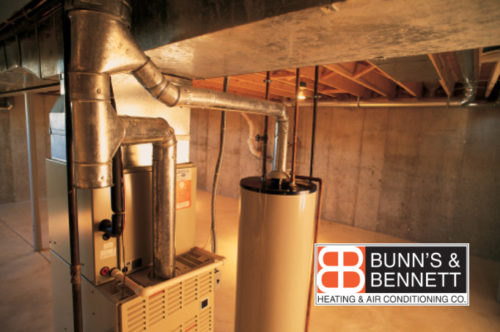No matter where you live in this great country of ours, there’s always a good chance that during almost any winter, you’re going to need some kind of home heating to keep your home comfortable. While some folks in southern-most Alabama may beg to differ, it’s no surprise that practically every home from Huntsville to Gulf Shores has a furnace. Of course, not every region in the U.S. favors the same type of heating system. For example, natural gas or propane heat is favored for most of the rural midwest while many northern cities still retain boilers and radiators.
Because we know our customers save more money by understanding how they use energy, we’ve put together this basic guide to the different types of home heating systems in use so that homeowners can learn about the kind of heating system they have and how it works.
The Two Basic Types of Heat Systems
Basically, there are two kinds of heating systems, forced air and radiant.
Forced air systems use a blower or fan to pull air into the system to be heated and then blown out to be circulated throughout the home. They can be noisy with metallic squeaks from loose connections or vibrate when running and require routine air filter changes to keep them running well. But because they heat the air, they tend to warm up homes quickly. A forced air system is composed of air return ductwork, blower, a heating or cooling unit with heat exchangers housed inside the air handler cabinet, a plenum where the air exits the air handler, and supply ductwork. The supply ductwork carries the air to all the rooms of the home while the return ductwork carries all the air from the rooms back to the blower and air handler.
Radiant systems rely on the use of heat to move air through convection. That is, heated air rises and is replaced by cooler air which is heated and rises and so on again. Because these systems essentially work passively, they tend to heat rooms slowly. Plus, they don’t filter dust or allergens from the air and in some cases, are not as energy efficient. However, most are inexpensive to buy, install, and maintain.
Force Air Systems
Electric resistance heating is 100% energy efficient because all the electricity is converted to heat. And since the heating elements in an electric furnace are in direct contact with the air, the air heats up very quickly. This makes them very efficient but expensive to operate during extended cold weather.
Types of Force Air Systems
- In natural gas/propane systems, you want the heat from the fire to heat the air but you also want to send the combustion exhaust out of the house. Gas burns on several long ribbon burners (12″ to 18″ long). The heat exchange resembles a tall, hollow hair comb that surrounds each ribbon burner on three sides. The hot gases move up into the heat exchanger and eventually exhaust out into the vent pipe. On highly efficient condensing gas furnaces, so much heat is wrung out of the exhaust that it won’t rise well enough to leave. This is why the system uses a fan to blow the exhaust outside.
- Heat pumps include both the regular outdoor and geothermal condensers. Both use R-410A refrigerant that is also used in air conditioning except that process runs in reverse so that instead of the warm air being blown off outside as waste heat, it’s blown off inside the system to supply heat. Heat pumps use compressor/condensing systems similar to regular air conditioning systems except that they are reversible. Geothermal systems do basically the same thing but instead of relying on the ambient air temperature to make heat, they use the temperature of subsurface ground which stays around 50°F, making it vey reliable and energy efficient.
- Ductless heat pump/ac systems are forced air systems that don’t use ductwork. Sometimes called “split systems”, the interior air handling and heat exchanging unit is directly connected to through the exterior wall to the outside unit. Because of their small size and the fact that they don’t use ductwork, split systems like these are best suited for heating and cooling small areas.
Radiant Systems
In the case of all heat radiating systems, these work silently and don’t buffet a room’s occupants with blasts of hot air. However, they tend to work more slowly to warm up a room when compared to forced air systems. This is largely due to the fact that they rely on convection to heat the air and make it circulate through the room. That said, different types of radiant systems work faster than others.
Radiant heat can be more efficient than forced air systems with duct loss problems, and some people with allergies prefer it because the lack of blowing air doesn’t stir up allergens. However, because these systems circulate water as either steam or liquid, radiator systems can be prone to problems such as blockages and leaks.
Types of Radiant Systems
- Solar— Passive solar is the greenest and least expensive to operate because the sun’s heat is stored in the thermal mass of the home. The sun’s heat radiates and warms the space. However, your home needs to be very well air sealed and insulated plus have adequate southern exposure to allow enough sunshine to enter the windows and warm the home. Unfortunately, the further north you go, the more expensive it can be to build a passive solar home and you may well need to have backup heating during cold snaps.
- Boiler-based systems include radiant floor heat that uses hot water, old-fashioned radiators that use steam or hot water, and also some hydronic (liquid-based) baseboard systems (see below). In these systems, a central boiler heats the water (or other liquid) to either steam or hot water and pumps it through pipes throughout the home to radiators or coils of tubing embedded in walls or flooring.
- Radiant floor heat makes use of the floor’s thermal mass. When you take hot water tubing and arrange it in loops on the floor and then a surround it with poured concrete (wet installation) or a sandwich of tile and plywood (dry installation), the floor will stay warm longer and radiate the heat longer, which keeps the room warm longer and more evenly. The bigger the floor space, the more of it can be heated and the more heat it will store.
Baseboard Heat: Electric (or “Convective”) and Hydronic Heaters
These heating systems work best when they are mounted at least 3/4″ above the floor or carpet. This allows cooler air on the floor to flow through the heater fins and be heated. One drawback is that fur from shedding pets can get pulled into these kinds of heaters and block airflow.
- Electric baseboard heaters (that use electric resistance heating elements) are mostly zonal heaters so each is controlled by a built-in thermostat —that is, a control knob. Available in lengths from 3 to 6 feet, each foot draws about 250 watts. Electric baseboard heaters tend to be the least expensive, easiest to install heating system. They only need to be wired up (with either 120 or 240 wiring) and fastened to the wall.
- Hydronic (liquid-based) baseboard systems use water or oil instead of electric resistance and tend to be a bit more expensive. The difference from electric resistance is that in resistance systems once the current shuts off, the heating element goes cold in just a few minutes. In hydronic systems, once the liquid is hot, it stays hot longer —making them a little more efficient to operate than electric resistance baseboards. Hydronic systems can be installed as individual units or as a single whole-house system that uses a single heater, much like a radiant or radiator system.
Which Type of Heating System Is Best?
It really depends on how your home is built, what you can afford, and what you prefer. For example, if you are building an addition or are modernizing your home’s HVAC, you may find that it might not be feasible to run new ductwork to different parts of your home. In which case, you might need to consider some type of baseboard system coupled with a ductless mini system for summertime cooling. And while it has been argued that forced air systems do stir up allergens, when they are equipped with HEPA air filtration they do a much more efficient job of purging allergens from the air throughout the entire home. If it’s a matter of energy efficiency, then next to passive solar the most efficient is geothermal followed by its cousin, the heat pump. While these are very effective heating systems, during events like cold snaps or Polar Vortex visits they require heating backups — usually in the form of built-in auxiliary electric resistance heating elements.
If you’re thinking about updating your home’s heating system or even just need some maintenance, it’s best to contact a skilled professional like One Hour Air Conditioning and Heating for expert service.
Keep your home and wallet comfortable with an energy plan from Direct Energy. We have the tools and tips you need to track your appliances’ usage to save energy and money.
Contact Us
Bunn’s and Bennett Heating and Air is a locally owned, fully insured heating and air conditioning contractor. We’ve been serving the Tennessee Valley area for more than 35 years. If you have questions about your furnace or would like to schedule an appointment to have your comfort system checked out, email us at [email protected] or call us at 256-936-0967.





